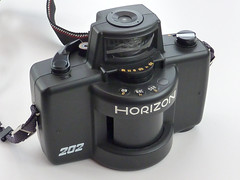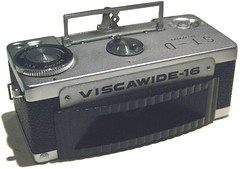Panorama camera
(Redirected from Panoramic camera)
Glossary Terms

|
| Horizon 202, a swing-lens 35mm panorama camera from KMZ image by Tony Kemplen (Image rights) |

|
| Viscawide 16 - gives 120° view on 16mm film using a fixed 25mm lens image by AWCam (Image rights) |
Panorama Cameras (or Panoramic Cameras) are cameras designed to take photos with a very wide horizontal angle, but normal vertical angle - resulting in normal height, but very wide photos. Typically these are of landscapes or large group of people arranged in a long row - such as the "classic" whole school or whole team photo (or, of course, very tall narrow photos of, say, tall buildings, if you turn the camera sideways).
There are several ways to design a panoramic camera to operate:
- Swing lens design. Keep the camera still, but swing a normal lens across the scene - perhaps using a slit-shaped shutter. This is the design concept for the Kodak Panoram, Krasnogorsk FT-2, Horizont, Al Vista, Widelux and similar cameras..
- Move the whole camera - manually, or with some motorised mechanism, keeping the film still by winding it in synchronisation with the rotation. Cameras such as the Globuscope and the Lomographic Spinner 360° work like this, and this method can give a full 360° view.
- Use a normal lens, or a conventional wide angle lens with a normal film frame, but add a (perhaps switchable) mask to crop the picture vertically; this is how the APS film panoramic format and the panorama setting on 35mm cameras such as the Olympus mju ZOOM 70 panorama are implemented. This method gives only an impression of a wide view, as the full frame would have the same angle of view on the long axis, but a wider angle on the short axis.
- Use a normal lens in a normal camera, but add a panoramic setting which rearranges the frame to spread across a number of normal-sized frames; some recent 35mm cameras have this feature. Some disposable cameras are fixed in this format, such as the Fuji QuickSnap Panorama 35mm and the Kodak Panoramic 35 disposables.
- Move the camera, taking a number of separate, normal-sized pictures, and assemble the frames into a single picture later. This is a technique which can be used on a number of digital cameras - usually requiring the user to move and aim the camera, and operate the shutter-release, with software providing a guide to lining up the shots.
- Rotate the camera, making a video recording. Use software to convert the video into a still image.
See Category: Panorama for some panoramic cameras.

|
| GlobuScope 360° rotating-head panorama camera image by KEH Camera (Image rights) |

|
| Baby Al Vista swing-lens camera 1901 image by Geoff Harrisson (Image rights) |
Sample Photos

|
| Sample photo created with swing-lens Widelux camera image by Jonathan Barrett Adams (Image rights) |

|
| Panorama created through software stitching of multiple images image by Voxphoto (Image rights) |